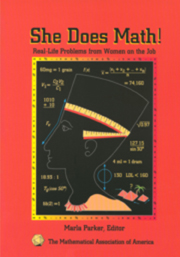Book contents
- Frontmatter
- Preface
- Contents
- Problems by Subject
- Environmental Psychology
- Software Engineering; Computer Science
- Archaeology
- Mathematics and Computer Science
- Civil Engineering
- Mathematics
- Electrical Engineering
- Physics; X-ray Astronomy Research
- Mathematics
- Physics; Astronaut Crew Training Instructor
- Business Data Processing
- Software Engineering; Real Estate Investment
- Quality Engineering
- Health Science
- Nursing Education
- Electrical Engineering; Space Systems
- Oil and Gas Accounting
- Business Administration Higher Education
- Aerospace Engineering
- Structural Engineering
- Computer Science
- Mathematics
- Dietetics—Foodservice Management and Nutrition
- Electrical Engineering
- Chemical Engineering, retired
- Software Engineering
- Immunology and Microbiology
- Mechanical Engineering
- HMO Pharmacy Practice and Management
- Ophthalmology
- Electrical Engineering
- Fish Pathology
- Computer Science and Computer Graphics
- Mathematics and Computing
- Electrical Engineering
- Astronomy
- Author
- Mathematics
- Reflections on WAM
- Solutions
Electrical Engineering; Space Systems
- Frontmatter
- Preface
- Contents
- Problems by Subject
- Environmental Psychology
- Software Engineering; Computer Science
- Archaeology
- Mathematics and Computer Science
- Civil Engineering
- Mathematics
- Electrical Engineering
- Physics; X-ray Astronomy Research
- Mathematics
- Physics; Astronaut Crew Training Instructor
- Business Data Processing
- Software Engineering; Real Estate Investment
- Quality Engineering
- Health Science
- Nursing Education
- Electrical Engineering; Space Systems
- Oil and Gas Accounting
- Business Administration Higher Education
- Aerospace Engineering
- Structural Engineering
- Computer Science
- Mathematics
- Dietetics—Foodservice Management and Nutrition
- Electrical Engineering
- Chemical Engineering, retired
- Software Engineering
- Immunology and Microbiology
- Mechanical Engineering
- HMO Pharmacy Practice and Management
- Ophthalmology
- Electrical Engineering
- Fish Pathology
- Computer Science and Computer Graphics
- Mathematics and Computing
- Electrical Engineering
- Astronomy
- Author
- Mathematics
- Reflections on WAM
- Solutions
Summary
I still remember how my first grade teacher, Mrs. Perkins, let us watch the Apollo rocket launches on television. The powerful technology inspired me to be a good student, so I could be a part of the space program. I enjoyed school and got a lot of encouragement from my family. My mom is an entomologist (a scientist who studies insects), and she has also been an inspiration. I still enjoy visiting her lab and peering through the microscope.
In high school I studied algebra, geometry, trigonometry, and calculus. As I progressed, I gradually decided that even though the language arts, social studies, and French courses I took were easier, I still wanted a career in math or science. Those fields offer challenging jobs that pay well, and I still dreamed of being involved in the U.S. space program. I was also attracted to the mystique surrounding math and science. They were subjects with a certain prestige, ones that not just anyone could master.
Eventually, I realized that math and science weren't that mysterious, and I could successfully pursue them. At the University of Washington, I studied electrical engineering, because I thought it was more versatile than aeronautical/astronautical engineering. When I graduated in 1984, I received eight job offers. I selected the Boeing Company because it gave me a chance to help develop the next generation of space solar power technology.
- Type
- Chapter
- Information
- She Does Math!Real-Life Problems from Women on the Job, pp. 61 - 62Publisher: Mathematical Association of AmericaPrint publication year: 1995



